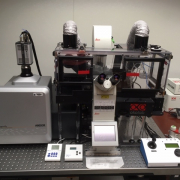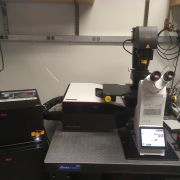- High speed multi-modal imaging with optical sectioning with 25um and 40um pinhole sizes
- Four laser lines: 405nm, 488nm, 561nm, 637nm
- Environmental control for samples which need heating and CO2
- Microscope autofocus control for time-lapse imaging
- Additional technologies: TIRF, SRRF, point localization super-resolution, MicroPoint laser ablation, and Mosaic 3 photostimulation
- High-speed multidimensional imaging with optical sectioning
- Spinning disk modality produces high SNR images with minimal photobleaching
- High sensitivity EMCCD camera
- Laser lines for all classes of fluorscent proteins
- Incubation for mammalian cells
- IR reflection based autofocus
- Silicon oil 60x objective for RI match
- Widefield imaging of living and fixed samples
- Optimized deconvolution
- Solid-state illumination, fast excitation switching
- Temperature, humidity, CO2 control
- Hardware-based autofocus
- High-precision XYZ stage
- Dual cameras - high-resolution and high-sensitivity
- 405 nm and 488 nm lasers for photoactivation and photo-bleaching experiments
- Optical axis integration/z-sweep acquisition
- Kohler and critical illumination
- Leica point scanning confocal microscope
- Inverted Leica DMI8 microscope stand with Adaptive Focus Control and x,y scanning stage
- Pulsed White Light Laser (440nm-790nm) for imaging wide-range of fluorophores from blue to near infrared
- 5 high-sensitivity and low-noise spectral HyD detectors, all with photon counting and time-gating capability
- Imaging based on spectrum or by fluorescence lifetime: TauSense and Fluorescent Lifetime Imaging Microscopy (FLIM)
- Notch filters to further reduce background
- Conventional and resonant scanners
- LAS X software with 'LAS Dye Finder', 'LAS X 3D' image viewer and 'LAS X Navigator' for convenient tile-scanning and stitching
- Imaging living samples and fixed samples - any fluorescent protein
- Temperature, humidity, CO2 control
- High sensitivity - EMCCD camera
- Multiposition timelapse
- Tiled images
- Incubation system allowing multi-day timelapse
- Fluorescence and transmitted light DIC imaging
- Up to 8 samples can be imaged per timelapse
- Multiposition timelapse
- Z-stacks
- Liquid handling - change media or add drugs




